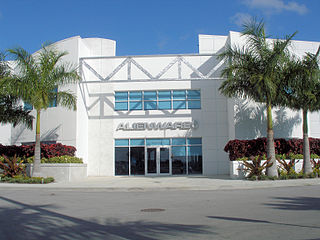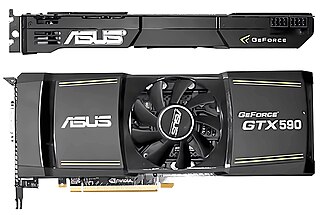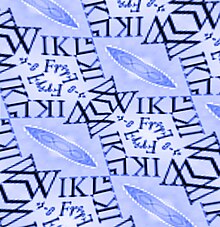
OpenGL is a cross-language, cross-platform application programming interface (API) for rendering 2D and 3D vector graphics. The API is typically used to interact with a graphics processing unit (GPU), to achieve hardware-accelerated rendering.

GeForce is a brand of graphics processing units (GPUs) designed by Nvidia. As of the GeForce 40 series, there have been eighteen iterations of the design. The first GeForce products were discrete GPUs designed for add-on graphics boards, intended for the high-margin PC gaming market, and later diversification of the product line covered all tiers of the PC graphics market, ranging from cost-sensitive GPUs integrated on motherboards, to mainstream add-in retail boards. Most recently, GeForce technology has been introduced into Nvidia's line of embedded application processors, designed for electronic handhelds and mobile handsets.

The GeForce FX or "GeForce 5" series is a line of graphics processing units from the manufacturer Nvidia.

A graphics processing unit (GPU) is a specialized electronic circuit designed to manipulate and alter memory to accelerate the creation of images in a frame buffer intended for output to a display device. GPUs are used in embedded systems, mobile phones, personal computers, workstations, and game consoles.

The GeForce 6 series is Nvidia's sixth generation of GeForce graphic processing units. Launched on April 14, 2004, the GeForce 6 family introduced PureVideo post-processing for video, SLI technology, and Shader Model 3.0 support.

Alienware is an American computer hardware subsidiary of Dell. Their product range is dedicated to gaming computers which can be identified by their alien-themed designs. Alienware was founded in 1996 by Nelson Gonzalez and Alex Aguila, and is currently led by Vivian Lien. The development of the company is also associated with Frank Azor, Arthur Lewis, Joe Balerdi, and Michael S. Dell. The company's corporate headquarters is located in The Hammocks, Miami, Florida.
Dell XPS is a line of consumer-oriented high-end laptop and desktop computers manufactured by Dell. The XPS mainly competes against computers such as Acer's Aspire, HP's Pavilion and Envy, Lenovo's X1, Samsung's Sens, and Apple MacBook Pro.

The GeForce 7 series is the seventh generation of Nvidia's GeForce graphics processing units. This was the last series available on AGP cards.
The Intel Graphics Media Accelerator (GMA) is a series of integrated graphics processors introduced in 2004 by Intel, replacing the earlier Intel Extreme Graphics series and being succeeded by the Intel HD and Iris Graphics series.

The R300 GPU, introduced in August 2002 and developed by ATI Technologies, is its third generation of GPU used in Radeon graphics cards. This GPU features 3D acceleration based upon Direct3D 9.0 and OpenGL 2.0, a major improvement in features and performance compared to the preceding R200 design. R300 was the first fully Direct3D 9-capable consumer graphics chip. The processors also include 2D GUI acceleration, video acceleration, and multiple display outputs.
The Taito Type X is an arcade system board released in 2004 by game developer and publisher Taito.
The GeForce 8 series is the eighth generation of Nvidia's GeForce line of graphics processing units. The third major GPU architecture developed by Nvidia, Tesla represents the company's first unified shader architecture.

The GeForce 9 series is the ninth generation of Nvidia's GeForce series of graphics processing units, the first of which was released on February 21, 2008. Products are based on a slightly repolished Tesla microarchitecture, adding PCIe 2.0 support, improved color and z-compression, and built on a 65 nm process, later using 55 nm process to reduce power consumption and die size.

Tesla is the codename for a GPU microarchitecture developed by Nvidia, and released in 2006, as the successor to Curie microarchitecture. It was named after the pioneering electrical engineer Nikola Tesla. As Nvidia's first microarchitecture to implement unified shaders, it was used with GeForce 8 Series, GeForce 9 Series, GeForce 100 Series, GeForce 200 Series, and GeForce 300 Series of GPUs collectively manufactured in 90 nm, 80 nm, 65 nm, 55 nm, and 40 nm. It was also in the GeForce 405 and in the Quadro FX, Quadro x000, Quadro NVS series, and Nvidia Tesla computing modules.
PureVideo is Nvidia's hardware SIP core that performs video decoding. PureVideo is integrated into some of the Nvidia GPUs, and it supports hardware decoding of multiple video codec standards: MPEG-2, VC-1, H.264, HEVC, and AV1. PureVideo occupies a considerable amount of a GPU's die area and should not be confused with Nvidia NVENC. In addition to video decoding on chip, PureVideo offers features such as edge enhancement, noise reduction, deinterlacing, dynamic contrast enhancement and color enhancement.

The Northern Islands series is a family of GPUs developed by Advanced Micro Devices (AMD) forming part of its Radeon-brand, based on the 40 nm process. Some models are based on TeraScale 2 (VLIW5), some on the new TeraScale 3 (VLIW4) introduced with them.

A refresh of the Fermi based GeForce 400 series, the GeForce 500 series is a series of graphics processing units developed by Nvidia, first released on November 9, 2010 with the GeForce GTX 580.

The R300 GPU, introduced in August 2002 and developed by ATI Technologies, is its third generation of GPU used in Radeon graphics cards. This GPU features 3D acceleration based upon Direct3D 9.0 and OpenGL 2.0, a major improvement in features and performance compared to the preceding R200 design. R300 was the first fully Direct3D 9-capable consumer graphics chip. The processors also include 2D GUI acceleration, video acceleration, and multiple display outputs.

Cg and High-Level Shader Language (HLSL) are two names given to a high-level shading language developed by Nvidia and Microsoft for programming shaders. Cg/HLSL is based on the C programming language and although they share the same core syntax, some features of C were modified and new data types were added to make Cg/HLSL more suitable for programming graphics processing units.














